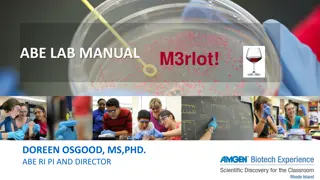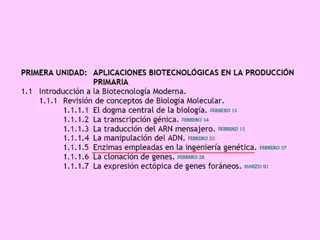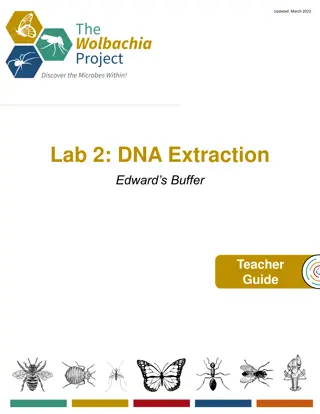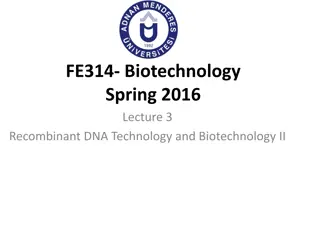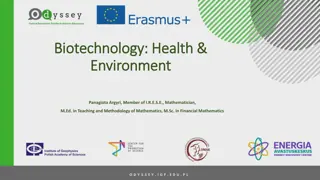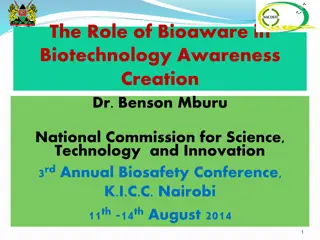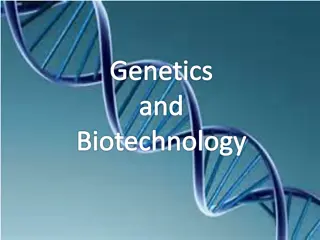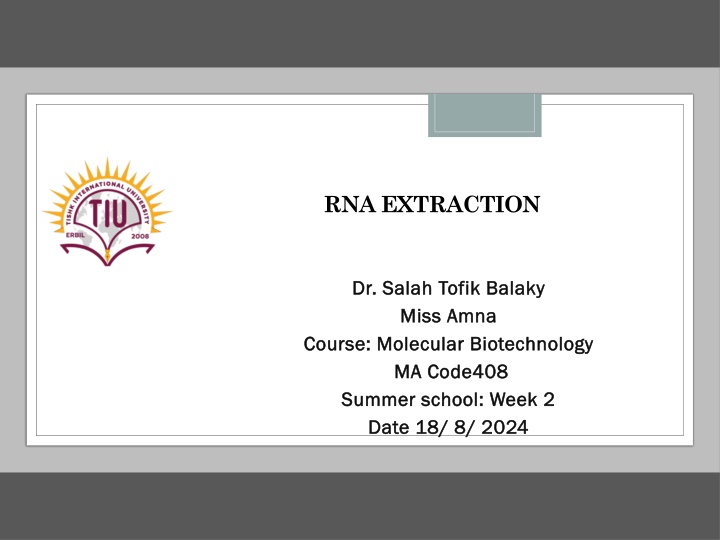
RNA Extraction Methods: Steps and Techniques
Discover the process of RNA extraction, including the main types of RNA, their percentages in cells, and the essential steps involved in isolating RNA from biological samples. Learn about cell lysis, nucleic acid partitioning, RNA retrieval, and quality assessment procedures, ensuring efficient and accurate RNA extraction for molecular biotechnology applications.
Download Presentation

Please find below an Image/Link to download the presentation.
The content on the website is provided AS IS for your information and personal use only. It may not be sold, licensed, or shared on other websites without obtaining consent from the author. If you encounter any issues during the download, it is possible that the publisher has removed the file from their server.
You are allowed to download the files provided on this website for personal or commercial use, subject to the condition that they are used lawfully. All files are the property of their respective owners.
The content on the website is provided AS IS for your information and personal use only. It may not be sold, licensed, or shared on other websites without obtaining consent from the author.
E N D
Presentation Transcript
RNA EXTRACTION Dr. Salah Dr. Salah Tofik Miss Amna Miss Amna Course: Molecular Biotechnology Course: Molecular Biotechnology MA Code408 MA Code408 Summer school: Week 2 Summer school: Week 2 Date 18/ 8/ 2024 Date 18/ 8/ 2024 Tofik Balaky Balaky
Main types of RNA Messenger RNA (mRNA): is a molecule that holds the DNA sequence and encodes for proteins or regulation products. Ribosomal RNA (rRNA): is part of the ribosome structure and is essential for protein synthesis in all living organisms. Transfer RNA (tRNA): is a type of RNA molecule that contributes to decoding the mRNA sequence into a protein.
Main types of RNA percentages The proportion of these three types of RNA varies in each cell. However, rRNA occupies 80% or more, followed by tRNA with 14% and ending with mRNA at about 2.5%.
RNA Extraction Total RNA isolation is a method based on liquid-phase separation which helps to obtain pure RNA in aqueous phase. The RNA obtained is precipitated, dissolved, and reprecipitated followed by washing in alcohol. During RNA solubilization and storage, care needs to be taken to avoid RNase contamination.
RNA Extraction steps (1) Cell lysis and homogenization. (2) Quenching of biochemical processes. (3) Nucleic acid partitioning. (4) RNA retrieval and crude purification. (5) Assessing the quality of the extracted RNA.
Step 1: Cell lysis and homogenization The first step requires effective cell lysis following homogenization for the complete release of nucleic acids. Several methods include chemical treatments such as detergents and enzymatic means such as lysozymes that disrupt cells to release cellular contents.
Step 2: Quenching of biochemical processes Solvents that solubilize cell contents should be denaturing (e.g., phenol chloroform). In most instances, cell lysis/ homogenization and quenching of biochemical processes are performed in the same step.
Step 3: Nucleic acid partitioning In nucleic acid isolation, the partitioning of DNA from RNA depends on pH. At an alkaline pH, DNA and RNA are retained in the aqueous phase. However, as pH decreases, DNA increasingly migrates from the aqueous phase to the organic phase and interphase. Therefore, phenol equilibrated to a pH of ~ 8 is used for the extraction of DNA while acid phenol of pH 4.8 is used to isolate RNA.
Step 4: RNA retrieval and crude purification. With RNA partitioned in a solvent, the next step is to retrieve the RNA with high yield and minimal artifacts. RNA contained in the aqueous phase can be extracted using a variety of methods. One of the commonly used methods is through precipitation with isopropanol.
Step 5: Assessing the quality of extracted RNA Several methods are employed to assess the quantity and quality of extracted RNA. The easiest approach is to estimate RNA concentration by UV absorbance (Nanodrop). The main drawbacks of spectroscopic approaches are the inability to evaluate RNA integrity. The issue of RNA integrity can be addressed by agarose gell electrophoresis.
Important consideration in RNA extraction Quality, DNA-free and integrity of purified RNA Extra care must be taken in RNA extraction, as the RNA is less stable than DNA. Addition of RNase inhibitors to the reaction sample, due to stability of RNase enzymes. To reduce DNA contamination samples must be treated with RNase-free DNase.
Principle of RNA Extraction from bacteria Trizol reagent has been widely used nowadays for the extraction of RNA from bacterial cell. Though it takes a slightly longer time than the commercially available column-based methods, it has high capacity to yield more RNA. While using the chaotropic lysis buffers, this method is considered to provide the best quality of RNA.
Reagents Required and Their Role 1. Luria Bertani Broth. 2. Tris EDTA (TE) Buffer pH 8. 3. Trizol: Trizol is a ready to use reagent for the isolation of total RNA from bacterial cells. This reagent is a monophasic solution of phenol and guanidine isothiocyanate. Trizol generally maintains the integrity of RNA as well as disrupting cells and dissolving cell membranes. Guanidine isothiocyanate is a powerful protein denaturant that also helps in inactivation of RNases.
4. Chemicals Required The following chemicals were required: 4 M guanidinium thiocyanate, 25 mM sodium citrate (pH 7.0), 0.5% (w/v) N-laurosylsarcosine and 0.1 M 2- mercaptoethanol. 5. Chloroform: is used to denature protein that settles in the bottom during RNA extraction. It also helps in the formation of aqueous and organic layer and in which RNA is dissolved in the aqueous layer.
6. Isopropyl Alcohol: RNA is insoluble in isopropyl alcohol; and hence, it aggregates and generates a pellet upon centrifugation. Addition of isopropyl alcohol also removes alcohol-soluble salts from the solution. As RNA is highly insoluble in isopropyl alcohol, it dissolves in water to form a solution that causes RNA to aggregate and precipitate.
Procedure 1. Inoculate a single bacterial colony into 5 ml of LB broth medium and incubate the tubes at 37 C for 24 h with shaking at 180 rpm. 2. Collect the bacterial cell pellet by centrifugation at 6000 rpm for 5 min at room temperature. 3. Wash the cell pellets twice with autoclaved phosphate buffer saline. 4. Wash the pellets with autoclaved TE buffer, centrifuge at 6000 rpm for 5 min at room temperature and collect the cell pellet. 5. Resuspend the cell pellet with 1.5 ml of trizol solution. 6. Homogenate the solution by repeated pipetting or alternatively by vortexing for 1 min. 7. RNA is stable in trizol as it deactivates RNases. Hence, at this step you can take a break for a shorter time or can store the samples by freezing it for a longer time. 9. Add 1/5 volume of chloroform, shake it to mix completely for 15 s.
Procedure 10. Incubate the solution at room temperature for 2 5 min. 11. Centrifuge the solution at 12,000 rpm for 10 min at 4 C. If centrifugation is not proper, DNA containing interphase will look cloudy and poorly compacted. 12. Transfer the upper aqueous layer to a fresh new tube. Take care not to aspirate the DNA containing white interface. This may lead to DNA contamination in the RNA preparation. 13. Add 1/2 initial volume of 70% ice-cold ethanol, and centrifuge at 10,000 rpm for 15 min at 4 C, discard the supernatant. 14. Wash the cell pellet with 500 l of 70% ethanol prepared with RNase-free water/ Diethylpyrocarbonate (DEPC)- treated water. 17. Dissolve pellet in 50 100 l of RNase-free water/DEPC-treated water, mix the pellet by pipetting up and down slowly. 18. Store the tubes at 80 C till further use.
Next lab PCR and RT-PCR in Molecular Biotechnology



